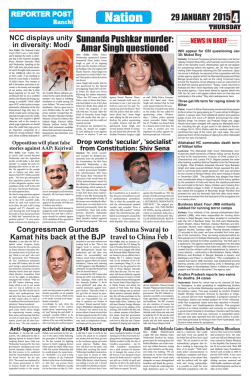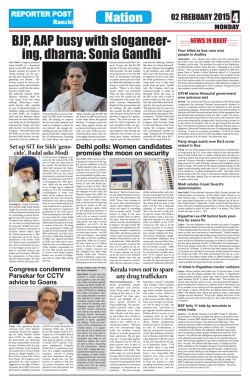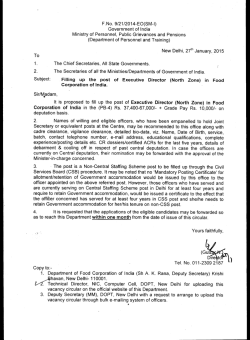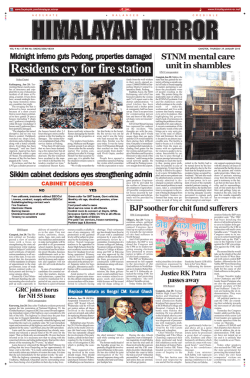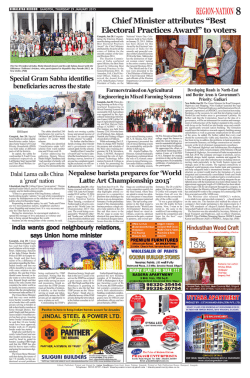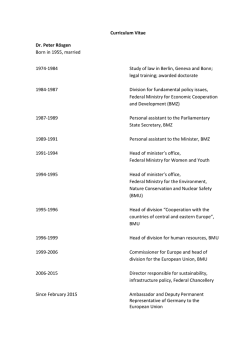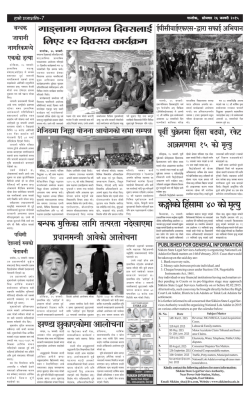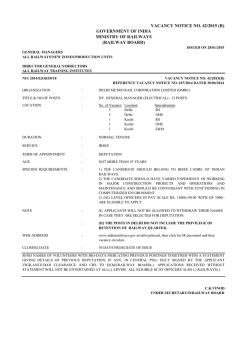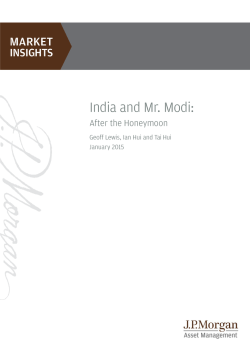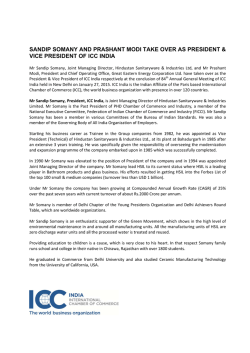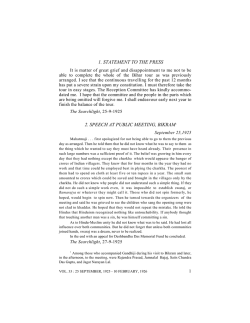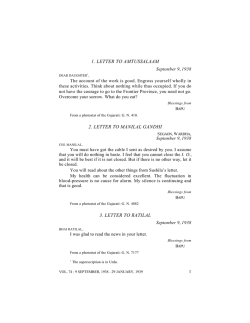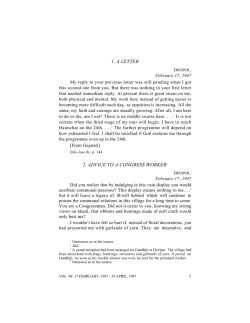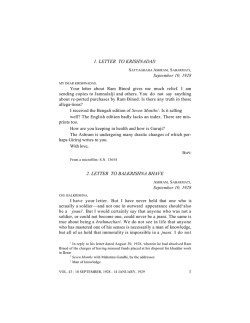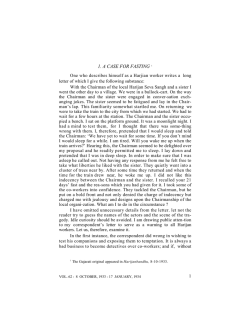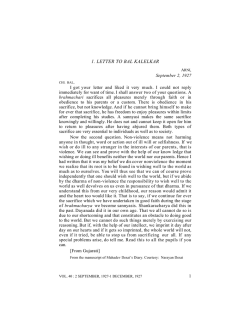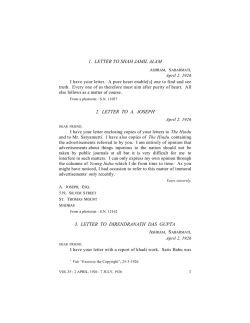
The art of the deal
4 HIMALAYAN MIRROR The art of the deal ENGLISH DAILY PUBLISHED FROM GANGTOK HIMALAYAN MIRROR FEBRUARY 01 2015 VOL 9 NO. 140 Bleak environment With just a week left before Delhi votes, the resignation of former minister and party spokesperson Jayanthi Natarajan is especially inauspicious for the Congress. The party now has a new front to battle. While claiming that she quit the Congress because the central leadership snubbed her despite her long years of service to the party, Natarajan has also insinuated that Sonia and Rahul Gandhi interfered with her work as minister of state for environment and forests. Finance minister Arun Jaitley has responded by seeking a review of all UPA 2 projects and the BJP has trained its guns on the Gandhis. A stunned Congress has called the resignation “image bachao abhiyan”, hinting at the shadowy circumstances of her being dropped from the Manmohan Singh government. The Congress has itself to blame for the mess. The move to set up the National Advisory Council (NAC) under Sonia Gandhi had weakened the prime minister’s authority substantially. That the NAC differed with the government on many issues further hindered policymaking. In her resignation, Natarajan has claimed that Sonia and Rahul Gandhi often directed her ministry on policy and clearances. She even lists specific projects that attracted the attention of the Gandhis. In other words, she has alleged that the NAC and Rahul Gandhi had assumed extra-constitutional roles and were intervening in the running of the government. Most unusually, several hundred files, many of them signed but nevertheless held back, were recovered from her office and residence after her resignation, as reported in this newspaper. Natarajan, who was a minister for 30 months before she was sacked, hints at what was wrong with the UPA set up. Two parallel power centres left the government listless and allowed ministries to be run as personal fiefs, triggering allegations ranging from policy paralysis to rent-seeking. The mess was most visible in the ministry of environment and forests, which had gained heft with the UPA’s green agenda and become a checkpost for project clearances. Ironically, Natarajan’s grievance is that the Gandhis seem to have ordered her sacking as minister though she always did their bidding. Her complaint doesn’t redeem her indifferent record as a minister. There is a lesson for the Congress in Natarajan’s complaint that her repeated requests to meet the party leadership went unheeded. Congress vice president Rahul Gandhi, who was “running a little busy” when Natarajan sought an appointment with him, has appeared hard pressed for time to manage party affairs. This is in stark contrast to the BJP leadership, which has understood the importance of constantly communicating with the public and cadres. Natarajan has specifically named Rahul Gandhi, and he must now come out and speak if he does not want to be made wholly irrelevant . C Raja Mohan T o understand the strategic significance of the second summit meeting between Prime Minister Narendra Modi and US President Barack Obama, it is necessary to look beyond the very important and tangible outcomes that the two leaders have unveiled. Closing the file on the historic civil nuclear initiative, expanding defence cooperation, exploring common ground on climate change and intensifying the engagement on regional security cooperation could not have been possible without the refreshing new diplomatic culture of problem-solving under the Modi government. For years now, progress on these issues has been held up principally by the Indian reluctance to negotiate purposefully. By combining strong political will with a laser-like focus on practical solutions, Modi has altered the narrative on India’s relationship with America. The Americans, by nature, like fixing problems when they find them. In India, it has been quite fashionable to accuse the US of being too transactional. The problem, however, is in the fact that Delhi had never been sufficiently transactional in the past. While this has been a generic problem with Indian diplomacy, Delhi’s preference for posturing had acquired an extra edge in dealings with America. Over the decades, a perverse political culture, wrapped in vacuous rhetoric, enveloped Indian foreign policymaking and turned Delhi into an odd-ball in the international arena. India would rather negotiate against its own long-term interests than find common ground with others. Standing up to America was considered an overriding political virtue. Whether it was negotiating on trade, climate change or nuclear policy at the multilateral or bilateral level, defending inherited positions became the dominant foreign policy tradition. Saying “no” was considered more heroic than splitting the difference and making progress. Part of the problem was the inability of the political classes to continually review and update the definition of India’s national interests by taking into account the changing domestic imperatives and external circumstances. This in turn filtered down to the bureaucracy, which revelled in being prickly with the US. Even a cursory look at the Indian and Chinese approaches to America reveals the con- Power is of two kinds. One is obtained by the fear of punishment and the other by acts of love. Power based on love is a thousand times more effective and permanent then the one derived from fear of punishment. - Mahatma Gandhi trast between Beijing’s pragmatism and Delhi’s inflexibility. Beijing fought a costly war with America in the Korean Peninsula during 1950-53, a war which saw nearly half a million Chinese casualties, including both the dead and the wounded. Mao Zedong’s own son was killed in the war. Yet, less than two decades later, Mao, in a breathtaking geopolitical manoeuvre, engineered a rapprochement with the US to counter the Soviet Union. India, which never had occasion to fight with the US, continued to tell itself that the contradictions with America were permanent and offered no room for practical cooperation. If Mao’s shift was a strategic one, Deng Xiaoping recast China’s foreign policy orientation in more fundamental ways and turned the partnership with America into a powerful lever to build China’s comprehensive national power. In recent years, mounting problems with America have not prevented China’s leaders from cutting deals with it on issues ranging from climate change to IT. To be fair, India’s political leaders were quicker than its professional diplomats and strategic community to recognise the importance of a more productive relationship with the US. Indira Gandhi and Rajiv Gandhi launched the first serious efforts to normalise relations with America in the 1980s. Faced with the end of the Cold War and recognising India’s new logic of globalisation, then Prime Minister P.V. Narasimha Rao declared that the “sky is the limit” for cooperation with America. Former Prime Minister Atal Bihari Vajpayee called America a “natural ally” of India and his successor, Manmohan Singh, signed the nuclear and defence agreements with Washington. These frequent attempts at changing India’s relationship with America repeatedly ran into political opposition and bureaucratic resistance. Even when major historic opportunities presented themselves, as in the first two years of the UPA government, Delhi found it hard to implement the agreements that it had signed with Washington. Three important shifts that Modi has forced on Delhi are at the root of the prime minister’s unexpected success with Obama. One, at the strategic level, Modi has concluded that a strong partnership with America was in India’s longterm interest. Two, Modi has sought an end to India’s tradition of reactive diplomacy and demanded that Delhi take the initiative. Unlike in the UPA era, when all the big ideas for transforming the relationship came from Washington, Modi demanded that Delhi take the lead in seeking a resolution of the outstanding issues and find- ing new areas of cooperation. Three, he demanded a flexible negotiating strategy that focuses on outcomes rather than the mindless defence of outdated positions. Once Obama found Modi could get things moving on the Indian side, it was not difficult for the two to deliver substantive understandings. Modi’s transformation of India’s diplomatic culture is not just about warming up to the US. Delhi’s new clarity on India’s long-term interests and its vigorous pursuit of pragmatic solutions is bound to have an impact on how the NDA government deals with the rest of the world, both at the bilateral and the multilateral levels. Modi’s engagement with China, for example, has already signalled a more creative approach towards Beijing. The Modi government has been far more open to economic cooperation with China than its predecessors. Contrary to the emerging misperception that the Obama visit is all about countering China, the prime minister is determined to generate new political opportunities with Beijing. Much in the manner that Deng normalised relations with the Soviet Union and resolved the boundary dispute with Moscow after strengthening ties with Washington, Modi is in a good position to make a vigorous bid to resolve longstanding issues with Beijing. Like the Americans, the Chinese are masters of realpolitik. After Modi demonstrated the art of the deal with America, it will be worth watching the sequel when the prime minister heads to China in the not too distant future. (Courtesy : Indian Express) Thinking local Inspired by Bollywood Movies are often and sometimes unfairly blamed for all manner of behavioural ills that afflict society — from violence and murder to an inability to form meaningful relationships. Rarely, though, has Bollywood been invoked as a defence for inappropriate and creepy behaviour. But this week, an Indian man escaped conviction by an Australian court for stalking two women, on the assertion that Hindi films led him to believe that a woman could not help but give in to the hitherto unwanted attentions of a man, so long as he was persistent enough. That such an argument was employed might not be cause for the film industry to rethink its portrayal of screen romance, but that a court of law actually found it persuasive, should. This is not to suggest that the government or the scissor-happy and arbitrary Central Board of Film Certification should get involved in setting up guidelines or rules or worse, laws, for how relationships should be depicted in cinema. But it is disingenuous for the Hindi film industry to continuously and vociferously argue that it doesn’t contribute to the problematic ways in which Indian men view women. Numerous films hammer in the idea that “no” is just the opening gambit; women are open to negotiation and/or the emotional blackmail a truly lovelorn “hero” subjects her to, like in the 2013 hit, Raanjhanaa, to name just one example. This kind of harassment is usually rewarded with the affections of the female love interest, who has been stalked into submission, and even valourised, both within the world of the film and in the minds of at least some of its viewers. In a country where the notion of “normal” male-female interaction is already so skewed, such depictions, so divorced from reality, add to the problem. EDITORIAL GANGTOK, SUNDAY 01 FEBRUARY 2015 In Fond memory of Bhim Raj Pradhan A Tribute to bid Adieu I remember Bhim Raj Pradhan (07 July 1937-20 January 2015)most as the one and the only person to have acknowledged in writing the efforts made by us to pay back the society in our own little humble way. It was not only a kind gesture but a great support and encouragement for us, indeed! His simple nature and harming personality always fascinated me ever since I came to know of him from my early days here when he visited Sanu Mama Mohan Pratap Pradhan* as they were colleagues with the same legal background to enter the Government service in July 1963. It was much later that I could come in contact with him when I was Joint Secretary in the Finance Department in charge of Income Tax and Sales Tax division and later as Secretary in different departments in course of government business to seek his valued advice.I was posted there by the then Finance Secretary K. C. Pradhan to check the growing menace of so called Gift racket by some traders here in Sikkim resorting to laundering of black money for some people including Bollywood film stars way back in 1980s. I was in close association with the then Advocate General JaganNath Rao* to deal with the tricky issue of tax matters. No sooner the defaulters replied to our notices, further enquiries made many a sleepless nights and thus we could check it to keep in bay the Indian Income Tax for quite some time though it was extended here. There were occasions when an advocate appearing for his client asked for the paper he had given me in writing previously. When I gave him he had gulped it down and swallowed much to my amazement. Another time a politician turned lawyer was refused to appear without a Vakalatnama to represent his client. I too was served once with anonymous letter threatening me for the action being taken and it was not very difficult to guess the person behind - hehad a tragic end some years ago. People realized that I was performing faithfully my solemn duty as a government servant assigned with the task that they express when we come across and meet now decades later. This much was my experience with the legal profession apart from an earlier brief stint as the District Collector-cum-District Magistrate in the south district. It was with the new Government that came to power in 1994 that I was promoted at last as the Secretary to the Government. After a year in the Food, Civil Supplies and Consumer Affairs Department I was entrusted with as many as three departments - Information and Public Relations, Printing and Stationeries and Election. It was while in the Information and Public Relations Department that I had the opportunity to work with Bindumati Pradhan, wife of Bhim Raj Pradhan. She was the Joint Secretaryand I got much support in taking up some innovative works that has been brought in landmark changes in the annals of history here. Sikkim Herald, the official news-bulletin of the Government got first ever change in the get upwith new masthead ever since it was started four decades ago. Besides all the language editions being printed in photo offset process, she had an important role to play in bringing out a new edition in the Newar language consequent upon it being accorded official status as one of the State languages by the Government. Around the same time, we on advice of my father Jai Shanker Lall Shresta*had quickly compiled and brought out Newa Varna, Lipi Ra Bhasha Parichaya under the auspices of newly founded Karuna Devi Smarak Dharmarth Guthi. It waswith a view to acknowledge and thank the Government for this generous grant and to help our people know not only about our script and language that make the Newar culture and tradition but of the rich heritage that needs to be preserved, promoted and protected.With a few but outstanding literary publications we brought out over the years that made Bhim Raj Pradhan write us kind words mentioned in the beginning of this article that reads as follows: Dear Rajiv, Thank you for your prompt action in sending me the publications under Karuna Devi Smarak Dharmarth Guthi. Your single handed endeavour with such publications - a gift to the society at large - must be applauded by one and all. And I join them all in the same. I am enclosing herewith a BOI a/c payee cheque No. 725460 dt.18.3.2006 for Rs. 2,106.00 as per your Bill. I am sorry for the delay. Congratulations and best wishes from us all at Lakshmi Nivas, Gangtok. Yours sincerely, B.R.Pradhan Born in the illustrious Lakshmi Nivasfamily of Kashi Raj Pradhan blessed by the GoddessSaraswati that gave us the Kanchanjungha the first news-magazine of Sikkim, Bhim Raj Pradhan himself was fond of and a patron to books and periodicals and people dedicated to this cause. Durga Prasad Shrestha, Editor-Publisher of the Uday was here with his brother Bijay to seek support for the Nepali literary magazine that was started way back in 1934 by his father Kashi Bahadur Shrestha that gave a landing stone to many a writers of fame later, we were invited for a dinner at Lakshmi Nivas. We were overwhelmed by the warm hospitality extended to us and Bindumati Didi recollected how our families were close when she as a child often visited our Nepali Kothi at Banaras for holidays. Her father Purna Das Shrestha too was a writer of repute both in Newar/Nepal Bhasha and Nepali with DhankoBala fame besides owning a successful business in Bombay. When almost all the doors found closed and the oldest literary publication was at the verge of its end, we took up in 2003 the Uday BachaoAbhiyan under the aegis of our Karuna Devi Smarak Dharmarth Guthi. On knowing about it, Bhim Raj Pradhan readily subscribed to it as a Life Member inall support. --When I joined the Government service after two year Courseas a Royal Sikkim Civil Service Probationer in Home Department, Bhim Raj Pradhan was the District and Session Judge and held in high esteem here. By relation we had high regardsfor him - not by me alone but by our entire family as he was our Bajey and Kaka for my Muma and all Mamas.With the marriage of my eldest sister Sunita* in their family with his cousin Uday* in 1980, our relation got nearer. For the people of Sikkim it was his bringing out the monumental compilation of all Laws of almost of a century promulgated from 1897 to 1990 into The Sikkim Code in 2 volumes besides some initial issues of The Sikkim Law Reporter published by the Law Department. His other great contribution was compilation of Criminal Justice India Series Volume 18 on Sikkim(ISBN 81-7764-835-7 : 2005)published by the National University of Juridical Sciences, Kolkata.For this a task force consisting of K. C. Pradhan, IAS (Retd.), K.T. Bhutia, Advocate, Bhasker Raj Pradhan, Advocate, TopgyalTsering Bhutia, Senior Superintendent of Police (Retd.) was constituted in August 2004that had Bhim Raj Pradhan, Former Law Remembrancer and Law Secretary as the coordinator and Bhasker Raj Pradhan as the joint coordinator. They were assisted in research works by YangchenDomaGyatso and Naresh Raj Shrestha both Advocates. Justice R. K. Patra* and Justice Malay Sengupta, both Former Chief Justice here were also associated with this projectfunded by the Ford Foundation. The Sikkim Bhutia Lepcha Apex Committee (SIBLAC) has paid a fitting tribute in his fond memory thus: We always adhere and appreciate his curiosity and concern in upholding and maintaining the sacredness of the existing old laws of Sikkim while he was a repository of the same. In fact, all his virtues deeds as the Law secretary of Sikkim shall be cherished by our posterity while he was the basic skeleton in composing the old codes which is now a legal document, a document which serves and saves Sikkim for all time to come, if implemented in letter and spirit, both by our policy makers and commoners. Beside the onerous task of compiling the old laws of Sikkim, B. R. Pradhan was instrumental in drafting the much needed Constitution for the Sikkim Newar Guthi in order to get it registered with the Government- very much like B. R. Ambedkar remembered for his contribution as the Principal Architect of the Constitution of India. Hewas associated with the activities of this body always ever since its inception but never came an occasion to felicitate him for this great contribution to our society. He is no more amidst us and thus goes a great soul an unsung hero. Like me, for him too his works are his awards and that makes me adore him more and always! In the words of K. C. Pradhan, Chief Patron of the Sikkim Newar Guthi -To the Newar community he was an icon and in his passing away it has created a big void. Very conversant with rituals and customs of the community, he never failed to celebrate the occasion of the community in great style and as well take part on it till very recently despite his ill health.Truly, it was wonderful opportunity to congratulate Bhim Raj Pradhan and Bindumati Pradhan on the occasion of the Golden Anniversary of their wedding celebrated in a grand manner amidst his friends and family members in 23rdAugust 2013. Again on 3rd March 2014 there was another occasion and it was to celebrate their Jankwa or Bhimratharohan on attaining the age of 77+ years. The family helped our clan to be together again and againwhen we did not know that he was leaving us all so soon. He is now no more amidst us but he will always be in our hearts. Rajiva Shanker Shresta With this tribute we bid adieu! Disclaime r: This is a personal account of memories to cherish and treasure often on a detour here and there en route to share the joy and sorrow of the journey called life. Some names and events mentioned are just to connect with and no malice whatsoever intended. Names with *asterisk denote those no more amidst us. He can be reached on [email protected] or phone 9434022677 / 03592-202677 and at Rachna, opposite Manan Bhavan, Development Area, Gangtok 737 101 Sikkim India.
© Copyright 2024
